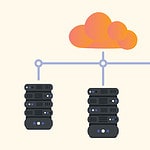[ad_1]
Servers have long been a standard part of business networks. They’re responsible for a lot of the heavy lifting behind the scenes. But, what happens when something goes wrong? Because they do so much for any given business, servers have a tendency to cripple a company when they go down.

The best approach is to understand what servers do and to make sure that monitoring is a critical part of your IT practices. As with any kind of monitoring, paying attention to what’s happening and noticing issues when they’re small, saves you money and time by preventing these small problems from becoming huge.
What are servers and what do they do?
Servers are computers that exist behind the scenes that store, process, and manage the information and devices that your business uses. Servers typically do their jobs using your company network and are responsible for providing access to and managing important aspects of your business, like printers, email, and any software your business uses.
In the old days, servers needed to be physically located in the same buildings as the company. These on-premises servers were racks of hard drives in climate-controlled spaces. And, while these on-prem setups still exist, the shift to the cloud means that a lot of organizations are using servers that are in the cloud, meaning they’re not on-site anymore.
The kinds of servers that you have at your business depends on your needs. Some of the more common types include:
- Application servers – These host the applications that you use during your daily work.
- Mail Servers – Host and send any company-based email that you’re using. If you’ve got your own domain, and most organizations do these days, odds are you’re also using a mail server to manage and store emails.
- FTP Servers – These are servers that allow you to upload and download files that you use in your business. These are more commonly being replaced by platforms like Dropbox or Microsoft OneDrive.
- Real-Time Communication Server – As the name implies, these servers host the communication tools that you use. These days, a lot of communication is hosted by third parties, though, like Slack or WhatsApp.
- Web Server – These host and deliver the web pages that you use on a regular basis, including your business website.
Why server monitoring matters
As we’ve mentioned, servers form the backbone of your IT infrastructure. If any one of them goes offline, you’re in a position where you’re unable to work, serve your customers, or even communicate with each other. Server monitoring is critical because it protects your business.
Any kind of infrastructure monitoring gives you the opportunity to catch small problems before they get big. Not only that, but as you collect data and analytics you gain deeper insight into how you’re using your servers, what they’re ultimately being used for, when peak times are, and more. This knowledge gives you the ability to both optimize your systems, but also make sure that everything is running smoothly when you need it the most. For example, if you see peaks at certain times, you can add capacity for those moments to prevent things from slowing down.
Ultimately, the more data you have, the better prepared you are for problems, busy periods, and anything else that may come up.
How to ensure better server monitoring and performance
Like a lot of things, maintaining and monitoring your servers can take a while to get right and what you’re doing depends a lot on what’s important to your business. That’s why two important first steps are establishing a clear baseline, so you know what normal looks like for your system. And, determining what metrics matter most to you. The step is critical because if you’re monitoring and analyzing the wrong data, you’re going to potentially miss a lot of issues that are holding your business back. The metrics you track should align with your business model and goals.
Once you know the baseline, set up alerts to let you know what’s going on with your servers. Be as thorough as you can be here. It might seem like you end up getting a lot of alerts at times, but the more aware you are, the better. Eventually, you’ll get a sense of which ones you truly need to watch and which ones aren’t as important. But, don’t create a habit of ignoring the alerts, and don’t rely on one delivery method, like email. This is important because, for example, if your email server goes down or is experiencing issues, you’re not going to see the alerts you’re getting.
It’s also worth noting that you shouldn’t rely on metrics you’re getting from software vendors exclusively. With outside software vendors, there’s a temptation to rely on what they’re telling you, but redundancy is your friend here. If you’re also monitoring these services, you can stay on top of issues like downtime.
Some examples of what you should be monitoring for include:
- Network interface availability
- Disk capacity
- Server capacity
- Server uptime
- Suspicious programs running
- Too many login attempts
- Malicious code
Remember, exactly what you’re monitoring is going to depend on what’s most important for your business, but details like uptime and capacity are critical, because if something goes offline (like your website) or your servers are suddenly full, doing your job becomes very hard.
What strategies can you use?
The two most common approaches are to manage monitoring in-house or have an outside team take care of monitoring for you.
Doing it in-house can be helpful because your internal IT team has intimate knowledge of what’s going on, what systems you’re using, and what normal looks like. The downside here is that it’s very easy for your in-house team to be too busy working on long-term strategic projects to keep an eye on the day-to-day tasks. The last thing you want is a missed notification.
Having an outside team take care of monitoring is effective because it takes the pressure off your internal team (if you have one). You also often end up with more comprehensive monitoring because external teams can offer round-the-clock monitoring because they have people working around the clock, rather than a team that comes in, works 9 to 5, then goes home. This keeps your business running at all hours, rather than normal business hours, which is beneficial for companies that have customers in different time zones around the world.
Want to learn more about server monitoring for your business?
If you’d like to learn more about how server monitoring can help your business, but don’t have a team to keep an eye on things, let’s chat. Our experts have more than 20 years of experience in the IT field and know best practices and tricks to help businesses in an industry.
Contact us to learn more about how we can help.
The post Server monitoring – what is it and why it matters to your business appeared first on Manhattan Tech Support.
[ad_2]


